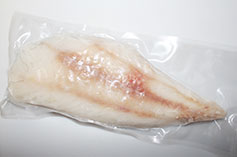
Cod Fish Fillet

Potato
Potato is the world’s 4th largest food crop following rice, wheat, and corn. Potatoes were first cultivated in Peru and Bolivia around 8,000 BC to 5,000 BC. The Inca Indians in Peru discovered a way to dehydrate and mash the potatoes, which they could store for a long time, and hence, potatoes became staple food in Peru.
In the mid-16th century, Spanish conquered Peru. They discovered the goodness of potatoes and carried them to Europe. Due its plain look and bland taste, people in Europe did not accept it as food and started using potatoes as livestock feed. However, the farmers in Europe found it easier to grow potatoes than other crops, hence potatoes became popular food crop there as well. Gradually, it spread around the world and has become staple food in many countries. Today, potato is grown in all 50 states in the USA and more than 125 countries throughout the world.
There are many varieties of potatoes categorized into starchy, waxy, and all-purpose types:
Starchy - Starchy potatoes are high in starch, low in moisture, and do not hold their shape well after cooking. Idaho Russet and Katahdin are examples of starchy potatoes. They are good for boiling, baking, and frying, but are not recommended for dishes like potato salads and casseroles which require firm-textured potatoes.
Waxy - Waxy potatoes are low in starch and are creamy and firm. They hold their shape after cooking. Red Bliss, Inca Gold, Fingerling, and New Potatoes are a few examples of waxy potatoes. This variety is excellent for cooking dishes that require firm potatoes, such as casseroles, potato salads, and gratin and can also be used for roasting, baking, boiling, and frying.
All-purpose - These potatoes are mild in starch; the starch content is more than waxy variety and less than starchy variety. All-purpose potatoes can be used for any cooking applications. Yukon gold and purple peruvian are examples of all-purpose potato.
Due to their mildly sweet taste, potatoes can be cooked in combination with other vegetables, meats, or spices to absorb their flavors and add impart its mild-sweetness to the dishes.
When buying, look for firm and clean potatoes with no discoloration, molds, or bruises. Store potatoes in a cool, dry, and ventilated place away from sunlight. The ideal temperature for storing potatoes is 50 degrees Fahrenheit or 10 degrees Celsius. An unheated basement or closet can be ideal for storing potatoes. At this temperature, potatoes will last for months. Storing potatoes at a temperature below 50 degrees Fahrenheit will convert its starch into sugar quickly, and you will end up with sweet tasting potatoes. On the other hand, higher temperature speeds up sprouting, water loss, and less firm potatoes. It’s recommended to buy less potatoes and use them quickly if you cannot store them at or around 50 degrees Fahrenheit.
Potatoes are gluten free, good source of carbohydrates, and are full of nutritional benefits needed for a healthy lifestyle. They are rich in minerals, such as potassium, iron, magnesium, calcium, and zinc, which help in building strong bones and maintaining a good blood pressure. They are also low in sodium and cholesterol and high in vitamin C and B6 that reduce inflammation and risk of heart disease. Fiber in potatoes promote a healthy digestive tract. Phytochemicals (antioxidants) along with vitamin C help prevent damage due to formation of free radicals.
In the mid-16th century, Spanish conquered Peru. They discovered the goodness of potatoes and carried them to Europe. Due its plain look and bland taste, people in Europe did not accept it as food and started using potatoes as livestock feed. However, the farmers in Europe found it easier to grow potatoes than other crops, hence potatoes became popular food crop there as well. Gradually, it spread around the world and has become staple food in many countries. Today, potato is grown in all 50 states in the USA and more than 125 countries throughout the world.
There are many varieties of potatoes categorized into starchy, waxy, and all-purpose types:
Starchy - Starchy potatoes are high in starch, low in moisture, and do not hold their shape well after cooking. Idaho Russet and Katahdin are examples of starchy potatoes. They are good for boiling, baking, and frying, but are not recommended for dishes like potato salads and casseroles which require firm-textured potatoes.
Waxy - Waxy potatoes are low in starch and are creamy and firm. They hold their shape after cooking. Red Bliss, Inca Gold, Fingerling, and New Potatoes are a few examples of waxy potatoes. This variety is excellent for cooking dishes that require firm potatoes, such as casseroles, potato salads, and gratin and can also be used for roasting, baking, boiling, and frying.
All-purpose - These potatoes are mild in starch; the starch content is more than waxy variety and less than starchy variety. All-purpose potatoes can be used for any cooking applications. Yukon gold and purple peruvian are examples of all-purpose potato.
Due to their mildly sweet taste, potatoes can be cooked in combination with other vegetables, meats, or spices to absorb their flavors and add impart its mild-sweetness to the dishes.
When buying, look for firm and clean potatoes with no discoloration, molds, or bruises. Store potatoes in a cool, dry, and ventilated place away from sunlight. The ideal temperature for storing potatoes is 50 degrees Fahrenheit or 10 degrees Celsius. An unheated basement or closet can be ideal for storing potatoes. At this temperature, potatoes will last for months. Storing potatoes at a temperature below 50 degrees Fahrenheit will convert its starch into sugar quickly, and you will end up with sweet tasting potatoes. On the other hand, higher temperature speeds up sprouting, water loss, and less firm potatoes. It’s recommended to buy less potatoes and use them quickly if you cannot store them at or around 50 degrees Fahrenheit.
Potatoes are gluten free, good source of carbohydrates, and are full of nutritional benefits needed for a healthy lifestyle. They are rich in minerals, such as potassium, iron, magnesium, calcium, and zinc, which help in building strong bones and maintaining a good blood pressure. They are also low in sodium and cholesterol and high in vitamin C and B6 that reduce inflammation and risk of heart disease. Fiber in potatoes promote a healthy digestive tract. Phytochemicals (antioxidants) along with vitamin C help prevent damage due to formation of free radicals.
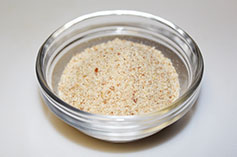
Breadcrumbs

Ginger
Native to Southeastern Asia, Ginger is popularly used as a spice and medicine in both eastern and western cultures. Ginger was used by ancient Romans and later, after the fall of Roman Empire, was traded in Europe by Arabs who took over the spice trade. Ginger became very expensive like other spices, and in medieval times, was traded in preserved form to make sweet treats.
For many years, ginger has been used to flavor a wide variety of food, from meats and sausages to fish and vegetables, and various curries as well as drinks and desserts. Fresh ginger can be used as sliced, crushed, or as paste.
Ginger has antioxidant and anti-inflammatory properties; therefore, it’s used in traditional medicine to cure a variety of ailments, such as, gastrointestinal distress, motion sickness, arthritis, and cold and flu. Cooking food with small quantity of ginger on a regular basis also adds to health benefits.
The distinct flavor and medicinal property of ginger comes from gingerols, shogaols, and zingerone. Fresh ginger contains gingerol an anti-inflammatory compound that is believed to help in reducing osteoarthritis or rheumatoid arthritis pain, if consumed on a regular basis. It may also prevent growth of certain cancer. Gingerol is transformed into shogaols when dried and cooked. Also, when ginger is cooked gingerol and shogaols is transformed into zingerone. Due to the presence of zingerone, food cooked with ginger has a sweet and spicy flavor. The anti-inflammatory and antioxidant properties of zingerone help in prevention and cure of many medical problems. Dry ginger alone has strong flavor due to shogaols used in many medicines as well as compliments cookies, cakes, and candies recipes, and tea and drinks.
In addition to the use for culinary and medicinal purposes, ginger is also used to fragrance many soaps and cosmetics.
Ginger is sold in many forms in supermarkets, such as fresh, dried, powdered, preserved, crystallized, and as oil. You will find ginger paste, a popular way of using ginger to make curries in Asian countries, in Asian and South Asian grocery stores. Be sure to use ginger in the recipe in the form it’s advised. For example, if a recipe calls for fresh ginger, it cannot be replaced with dry or powdered or other types. Each form of ginger has a distinct taste and different purpose.
Ginger is best stored as whole and unpeeled in a sealed plastic bag in refrigerator. If part of the ginger has been cut or peeled, be sure to dry it before storing. Other forms of ginger are mainly packaged and need to be stored as per instructions by the seller.
For many years, ginger has been used to flavor a wide variety of food, from meats and sausages to fish and vegetables, and various curries as well as drinks and desserts. Fresh ginger can be used as sliced, crushed, or as paste.
Ginger has antioxidant and anti-inflammatory properties; therefore, it’s used in traditional medicine to cure a variety of ailments, such as, gastrointestinal distress, motion sickness, arthritis, and cold and flu. Cooking food with small quantity of ginger on a regular basis also adds to health benefits.
The distinct flavor and medicinal property of ginger comes from gingerols, shogaols, and zingerone. Fresh ginger contains gingerol an anti-inflammatory compound that is believed to help in reducing osteoarthritis or rheumatoid arthritis pain, if consumed on a regular basis. It may also prevent growth of certain cancer. Gingerol is transformed into shogaols when dried and cooked. Also, when ginger is cooked gingerol and shogaols is transformed into zingerone. Due to the presence of zingerone, food cooked with ginger has a sweet and spicy flavor. The anti-inflammatory and antioxidant properties of zingerone help in prevention and cure of many medical problems. Dry ginger alone has strong flavor due to shogaols used in many medicines as well as compliments cookies, cakes, and candies recipes, and tea and drinks.
In addition to the use for culinary and medicinal purposes, ginger is also used to fragrance many soaps and cosmetics.
Ginger is sold in many forms in supermarkets, such as fresh, dried, powdered, preserved, crystallized, and as oil. You will find ginger paste, a popular way of using ginger to make curries in Asian countries, in Asian and South Asian grocery stores. Be sure to use ginger in the recipe in the form it’s advised. For example, if a recipe calls for fresh ginger, it cannot be replaced with dry or powdered or other types. Each form of ginger has a distinct taste and different purpose.
Ginger is best stored as whole and unpeeled in a sealed plastic bag in refrigerator. If part of the ginger has been cut or peeled, be sure to dry it before storing. Other forms of ginger are mainly packaged and need to be stored as per instructions by the seller.

Mint Leaves
Coming Soon...
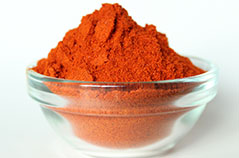
Red Chili Powder
Red chili powder is made by grinding dried deep red-brown thai chili peppers. Native to central and South America, red thai chili peppers were introduced to South Asia in 1500s and now India is the largest producer of these peppers in the world. Either in powdered or whole form, the chili peppers are used to add extra heat and spiciness to the dishes, which is due to the presence of a compound called capsaicin.
Red chili powder is a widely used spice for preparing a variety of curries, soups, stews, marinades, sauces, and dry rubs for barbecue. It is also used to flavor some sweet dishes such as cakes, brownies, truffles, and chocolates.
Red chili powder is a healthy seasoning. It contains significant amount of vitamin A and C, and beta carotenoids (a red-orange pigment that acts as an antioxidant and converts into vitamin A). It also helps to detoxify our body.
When purchasing red chili powder at store, look for the bright red colored powder for best taste. For making red chili powder at home:
Red chili powder is available in Indian and South Asian grocery stores. Some of the popular brands of red chili powder are Nirav, Deep, SWAD, Spicy World, and Everest. You may also find it in supermarkets or gourmet markets. It is available at online grocery stores such as amazon.com, where you will be able to choose from several brands.
Red chili powder is a widely used spice for preparing a variety of curries, soups, stews, marinades, sauces, and dry rubs for barbecue. It is also used to flavor some sweet dishes such as cakes, brownies, truffles, and chocolates.
Red chili powder is a healthy seasoning. It contains significant amount of vitamin A and C, and beta carotenoids (a red-orange pigment that acts as an antioxidant and converts into vitamin A). It also helps to detoxify our body.
When purchasing red chili powder at store, look for the bright red colored powder for best taste. For making red chili powder at home:
- Buy dry (not fresh) whole red thai chili peppers and remove the stems.
- Further dry the chili peppers in sun for a couple of days or slightly roast them for 2-3 minutes, without oil in a pan. Drying or roasting removes moisture from the chili peppers and adds extra crispness, which is required to powder them. Roasting the chili peppers enhances its flavor and aroma.
- Let the dried or roasted chili peppers cool down and then grind to a fine powder in a spice grinder. You can also use a coffee grinder for this purpose; however, the coffee grinder should be used for grinding spices only. It is not advisable to use the same grinder for spices and coffee.
Red chili powder is available in Indian and South Asian grocery stores. Some of the popular brands of red chili powder are Nirav, Deep, SWAD, Spicy World, and Everest. You may also find it in supermarkets or gourmet markets. It is available at online grocery stores such as amazon.com, where you will be able to choose from several brands.
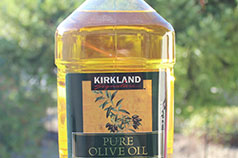
Olive Oil
Olive is one of the oldest known cultivated trees in the world. It is said that Olive trees are being cultivated before the invention of written language. Olive trees are draught tolerant and are native to eastern Mediterranean region. The trees can survive and bear fruits for a thousand year. Olives are small fruits of the Olive tree. During prehistoric time, people use to grind and drain the pulp of olives to get oil for cooking and lighting lamps. Oil extracted from olives was also used for cosmetic purposes.
Today, olive oil is popular than any other oil for culinary use and health benefits. About 90% of the olive fruit produce goes toward the production of olive oil. The oil is produced by pressing the whole olives and is used for cooking, cosmetics, pharmaceutical uses, and as fuel for certain lamps.
Olive oil used for cooking and eating is broadly classified as extra virgin, virgin, pure, and light. The difference is mainly in the process of production of different verities, due to which they contain different levels of antioxidant and have different smoking point.
Extra virgin olive oil is the best quality and is extracted using mechanical process such as cold pressing and centrifugation. The olives are pressed at normal temperature without the use of heating and chemicals. This method of extraction helps preserve most of the antioxidants and hence, makes the oil of high quality. The extra virgin olive oil smokes at a very low temperatures ranging from 200 to 372 degree Fahrenheit depending upon the quality (the better the quality have higher smoking point). Therefore, extra virgin olive oil is considered cold dishes like salad dressing and dips as well as cooking at a medium heat. You can use the good quality extra virgin oil to sauté vegetables, shallow frying eggs, and meats. It’s not recommended to use extra virgin olive oil for deep frying at higher temperatures.
Virgin olive oil is extracted using the same process as extra virgin. It has same levels of monounsaturated fats, antioxidant, and has the similar smoking point. It’s different from extra virgin because it’s made using relatively ripe olives, which gives it light flavor. The usage of virgin oil for cooking is same as extra virgin oil.
Pure olive oil has the same monounsaturated fat content, but has less antioxidant. Pure olive oil, also called olive oil, is a blend of virgin oil and refined pomace oil (also called refined olive oil). Pomace oil, a leftover during the extraction of extra virgin and virgin oils, is refined before mixing it to the virgin oil. The blend contains only about 5 to 10% of virgin oil. It’s lighter in taste, and has higher smoking point that makes it fit for sautéing and frying.
Light olive oil has the same percentage of monounsaturated fat, but lowest level of antioxidants. It’s basically refined olive oil, manufactured by the using some chemical and heat to get rid of impurities. It’s smoking point is highest and is ideal for high temperature cooking, such as deep frying and baking.
At higher temperatures, required for deep frying, extra virgin and virgin oil lose their antioxidant properties and flavor. Therefore, many cooks use pure or light olive oil for frying. Some views suggest that cooking with extra virgin and virgin olive oil at high temperatures is harmful for health; however, there is no substantial evidence to support such views. This might be a myth or a truth. Therefore, to be on the safe side, it’s advisable to use pure and light olive oil for higher temperature cooking such as deep frying, and use good quality extra virgin and virgin olive oil for cold dishes and cooking at medium temperature such as sautéing.
Because of the higher monounsaturated fat content, all kinds of olive oil lasts longer than other oils. After opening, close the cap or lid completely and store in a cool, dark, and dry place, and use it within 3 – 4 months from opening. Due to the presence of antioxidant substances, extra virgin and virgin oils are more resistant to damage by oxygen in air. However, the chlorophyll in the oil makes them vulnerable to damage by light. Therefore, always store the extra virgin and virgin oil in a dark place away from light. Refrigeration slightly solidifies the oil, which comes back to its liquid state when kept at room temperature, but will lose its flavor.
Olive oil has high content of antioxidants called polyphenols, carotenoids, and tocopherols. It’s high in monounsaturated fat and has low saturated and polyunsaturated fat. This composition makes it healthy for heart and for prevention of many medical conditions like, cancer, high blood pressure, and diabetes. According to some recent research, consumption of olive oil improves calcium absorption; hence, prevents the onset osteoporosis.
You can buy olive oil at any grocery store. It is available at online grocery stores such as www.amazon.com. Type the kind of olive oil you want to buy on search bar, you will be able to choose from several options.
Today, olive oil is popular than any other oil for culinary use and health benefits. About 90% of the olive fruit produce goes toward the production of olive oil. The oil is produced by pressing the whole olives and is used for cooking, cosmetics, pharmaceutical uses, and as fuel for certain lamps.
Olive oil used for cooking and eating is broadly classified as extra virgin, virgin, pure, and light. The difference is mainly in the process of production of different verities, due to which they contain different levels of antioxidant and have different smoking point.
Extra virgin olive oil is the best quality and is extracted using mechanical process such as cold pressing and centrifugation. The olives are pressed at normal temperature without the use of heating and chemicals. This method of extraction helps preserve most of the antioxidants and hence, makes the oil of high quality. The extra virgin olive oil smokes at a very low temperatures ranging from 200 to 372 degree Fahrenheit depending upon the quality (the better the quality have higher smoking point). Therefore, extra virgin olive oil is considered cold dishes like salad dressing and dips as well as cooking at a medium heat. You can use the good quality extra virgin oil to sauté vegetables, shallow frying eggs, and meats. It’s not recommended to use extra virgin olive oil for deep frying at higher temperatures.
Virgin olive oil is extracted using the same process as extra virgin. It has same levels of monounsaturated fats, antioxidant, and has the similar smoking point. It’s different from extra virgin because it’s made using relatively ripe olives, which gives it light flavor. The usage of virgin oil for cooking is same as extra virgin oil.
Pure olive oil has the same monounsaturated fat content, but has less antioxidant. Pure olive oil, also called olive oil, is a blend of virgin oil and refined pomace oil (also called refined olive oil). Pomace oil, a leftover during the extraction of extra virgin and virgin oils, is refined before mixing it to the virgin oil. The blend contains only about 5 to 10% of virgin oil. It’s lighter in taste, and has higher smoking point that makes it fit for sautéing and frying.
Light olive oil has the same percentage of monounsaturated fat, but lowest level of antioxidants. It’s basically refined olive oil, manufactured by the using some chemical and heat to get rid of impurities. It’s smoking point is highest and is ideal for high temperature cooking, such as deep frying and baking.
At higher temperatures, required for deep frying, extra virgin and virgin oil lose their antioxidant properties and flavor. Therefore, many cooks use pure or light olive oil for frying. Some views suggest that cooking with extra virgin and virgin olive oil at high temperatures is harmful for health; however, there is no substantial evidence to support such views. This might be a myth or a truth. Therefore, to be on the safe side, it’s advisable to use pure and light olive oil for higher temperature cooking such as deep frying, and use good quality extra virgin and virgin olive oil for cold dishes and cooking at medium temperature such as sautéing.
Because of the higher monounsaturated fat content, all kinds of olive oil lasts longer than other oils. After opening, close the cap or lid completely and store in a cool, dark, and dry place, and use it within 3 – 4 months from opening. Due to the presence of antioxidant substances, extra virgin and virgin oils are more resistant to damage by oxygen in air. However, the chlorophyll in the oil makes them vulnerable to damage by light. Therefore, always store the extra virgin and virgin oil in a dark place away from light. Refrigeration slightly solidifies the oil, which comes back to its liquid state when kept at room temperature, but will lose its flavor.
Olive oil has high content of antioxidants called polyphenols, carotenoids, and tocopherols. It’s high in monounsaturated fat and has low saturated and polyunsaturated fat. This composition makes it healthy for heart and for prevention of many medical conditions like, cancer, high blood pressure, and diabetes. According to some recent research, consumption of olive oil improves calcium absorption; hence, prevents the onset osteoporosis.
You can buy olive oil at any grocery store. It is available at online grocery stores such as www.amazon.com. Type the kind of olive oil you want to buy on search bar, you will be able to choose from several options.

Salt
Salt is a mineral composed of a chemical compound called sodium chloride. It is essential for human body to regulate fluid balance and to control function of nerves and muscles. Human body cannot produce its own salt and depends on various sources of salt in food for necessary daily intake.
In addition to being just a diet supplement, salt helps in extracting the real flavors of savory as well as sweet dishes. No other seasoning has been found so fulfilling to replace salt. However, the overuse of salt results into a lot of health problems, such as hypertension, heart disease, and strokes. Use salt mildly in your food to you can enjoy its goodness.
In addition to being just a diet supplement, salt helps in extracting the real flavors of savory as well as sweet dishes. No other seasoning has been found so fulfilling to replace salt. However, the overuse of salt results into a lot of health problems, such as hypertension, heart disease, and strokes. Use salt mildly in your food to you can enjoy its goodness.

Water
Coming Soon...

Egg
Coming Soon...
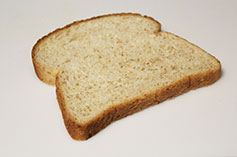
Bread

Garlic Cloves
Native to central Asia, Garlic is one of the earliest plants that human used for flavoring food dishes as well as maintaining a good health. Garlic became an important ingredient in cooking many dishes in various parts of the world, such as, Asian countries including Middle East, northern Africa, southern Europe, and parts of South and Central America. However, Garlic was not popular in the USA until the beginning of twentieth century. By the year 1940, Americans recognized the importance of Garlic and started using it to season various recipes.
A Garlic bulb is a bunch of individual segments called cloves (like an orange segment). Each Garlic clove can be separated off the bunch and peeled before use to flavor any recipe. A Garlic clove can be used as a whole, sliced, crushed, or in the form of paste. Each way of using Garlic provides a different flavor to the recipes. For example, whole and sliced garlic provides mild taste than crushed and paste form.
Due to higher concentration of fructose and significantly less water content, Garlic is browned quickly when frying or roasting. Therefore, Garlic needs to be cooked carefully. If you are cooking food in a pan or a wok, one way is to add Garlic toward the end of cooking, in the last few minutes. However, Garlic added at the end of the cooking will provide a stronger taste. Some people like it, some don’t. Cooking Garlic at the beginning will mellow down the strong taste. To add garlic at the beginning of cooking and yet prevent from burning, cook the Garlic at a low heat and preferably in a smaller pan or wok. You can change the heat from low to medium after adding other ingredients with garlic. Garlic cooked this way will provide mild taste to the food. Garlic is best roasted in an oven by wrapping the cloves or whole bulb in an aluminum foil at 400 degrees Fahrenheit for about 40 minutes.
Though garlic is best known for flavoring food, it has also been used to maintain good health and for increasing strength. Usage of garlic in food may also help prevent many heart and blood system related conditions, such as, high blood pressure, high cholesterol, and coronary heart disease. It’s also believed that consumption of garlic on a regular basis reduces the risk of getting certain cancer, such stomach cancer, colon cancer, and lung cancer. For maximum health benefits, slice, crush, or make garlic paste 10 minutes before cooking. When a garlic clove is broken down, the ruptured cell releases the sulphur-based compound, alliin and an enzyme called alliinase. They come in contact with each other to form a new compound called alliicin, which is responsible for medicinal properties of Garlic. Allowing the cut Garlic to sit for about 10 minutes before cooking provides maximum health benefits due to optimal synthesis of alliicin.
Whole fresh garlic should be stored at room temperature at dry and dark place with proper ventilation. Do not store garlic in closed plastic bags. It’s best to store garlic in netted or punched bags for better air circulation. Refrigeration or freezing changes the texture and flavor of garlic. However, cut or peeled garlic needs to sealed in a container or air tight bag and refrigerated for later use.
A Garlic bulb is a bunch of individual segments called cloves (like an orange segment). Each Garlic clove can be separated off the bunch and peeled before use to flavor any recipe. A Garlic clove can be used as a whole, sliced, crushed, or in the form of paste. Each way of using Garlic provides a different flavor to the recipes. For example, whole and sliced garlic provides mild taste than crushed and paste form.
Due to higher concentration of fructose and significantly less water content, Garlic is browned quickly when frying or roasting. Therefore, Garlic needs to be cooked carefully. If you are cooking food in a pan or a wok, one way is to add Garlic toward the end of cooking, in the last few minutes. However, Garlic added at the end of the cooking will provide a stronger taste. Some people like it, some don’t. Cooking Garlic at the beginning will mellow down the strong taste. To add garlic at the beginning of cooking and yet prevent from burning, cook the Garlic at a low heat and preferably in a smaller pan or wok. You can change the heat from low to medium after adding other ingredients with garlic. Garlic cooked this way will provide mild taste to the food. Garlic is best roasted in an oven by wrapping the cloves or whole bulb in an aluminum foil at 400 degrees Fahrenheit for about 40 minutes.
Though garlic is best known for flavoring food, it has also been used to maintain good health and for increasing strength. Usage of garlic in food may also help prevent many heart and blood system related conditions, such as, high blood pressure, high cholesterol, and coronary heart disease. It’s also believed that consumption of garlic on a regular basis reduces the risk of getting certain cancer, such stomach cancer, colon cancer, and lung cancer. For maximum health benefits, slice, crush, or make garlic paste 10 minutes before cooking. When a garlic clove is broken down, the ruptured cell releases the sulphur-based compound, alliin and an enzyme called alliinase. They come in contact with each other to form a new compound called alliicin, which is responsible for medicinal properties of Garlic. Allowing the cut Garlic to sit for about 10 minutes before cooking provides maximum health benefits due to optimal synthesis of alliicin.
Whole fresh garlic should be stored at room temperature at dry and dark place with proper ventilation. Do not store garlic in closed plastic bags. It’s best to store garlic in netted or punched bags for better air circulation. Refrigeration or freezing changes the texture and flavor of garlic. However, cut or peeled garlic needs to sealed in a container or air tight bag and refrigerated for later use.
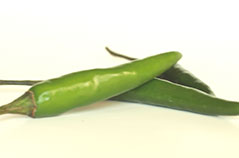
Thai Chili (Optional)
Thai chili pepper, also known as the Bird’s Eye or Bird pepper is one of the hottest chili peppers. It is small in size and high in heat and pungency. It is native to Mexico, Central America, and South America and is most commonly found in South Asia and Southeast Asia. It is a standard ingredient in South Asian and Southeast Asian cuisines and is used to add heat and spiciness to food.
In whole, chopped, or ground form, it is used to flavor curries, stews and soups, salads, hot sauces, marinades, rubs for barbecue, and seafood dishes. Chopped peppers with whole seeds add most heat and spiciness to the dishes, and it is a popular way of garnishing the savory dishes and salads in South Asian and Southeast Asian countries. To get mild spiciness and yet maintain the flavor and aroma of the chili peppers, completely remove the seeds and blanch the peppers.
Thai chili peppers ripen from green to orange and finally to bright red. The chili peppers at each stage are great for consumption and can also be used in combination. The mature red thai chili peppers are used in fresh as well as dried form. After harvesting, they are dried in sun for about 1 to 2 weeks, depending on the climate. They dry faster in climates with even sunlight and low moisture. Dried peppers have different flavor than fresh peppers and are chewy in texture. Dried red thai chili peppers are also ground to make red chili powder.
Thai chili peppers are sold in most of the supermarkets and Indian and South Asian grocery stores in the US. If not available, they can be replaced with serrano peppers. Store fresh thai chili peppers in a plastic bag, releasing as much air as possible, and refrigerate them. They will last for about 2 weeks in refrigerator. Store dried red thai chili peppers in a tightly closed jar in a dry and cool place, away from sunlight. They last for about a year if not in contact with moisture.
In whole, chopped, or ground form, it is used to flavor curries, stews and soups, salads, hot sauces, marinades, rubs for barbecue, and seafood dishes. Chopped peppers with whole seeds add most heat and spiciness to the dishes, and it is a popular way of garnishing the savory dishes and salads in South Asian and Southeast Asian countries. To get mild spiciness and yet maintain the flavor and aroma of the chili peppers, completely remove the seeds and blanch the peppers.
Thai chili peppers ripen from green to orange and finally to bright red. The chili peppers at each stage are great for consumption and can also be used in combination. The mature red thai chili peppers are used in fresh as well as dried form. After harvesting, they are dried in sun for about 1 to 2 weeks, depending on the climate. They dry faster in climates with even sunlight and low moisture. Dried peppers have different flavor than fresh peppers and are chewy in texture. Dried red thai chili peppers are also ground to make red chili powder.
Thai chili peppers are sold in most of the supermarkets and Indian and South Asian grocery stores in the US. If not available, they can be replaced with serrano peppers. Store fresh thai chili peppers in a plastic bag, releasing as much air as possible, and refrigerate them. They will last for about 2 weeks in refrigerator. Store dried red thai chili peppers in a tightly closed jar in a dry and cool place, away from sunlight. They last for about a year if not in contact with moisture.
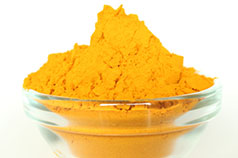
Turmeric Powder
Turmeric powder is a bright and deep yellow colored powder made by grinding dried underground stems of turmeric, which is starchy in nature. In India and some of its neighboring countries, turmeric in stem or powdered form has been used to color skin and clothing and to add color and aroma to food. It is also used as a pious powder during festivals and marriage ceremonies. In other parts of the world, turmeric is mainly used to add color and aroma to food. Turmeric has pungent and bitter taste but musky and mild fragrance.
Turmeric powder is made by steaming or boiling the underground stems in slightly alkaline water (measures above 7.0 on the pH scale) to precook the starch in turmeric. The alkaline water also improves the color of turmeric. Boiled turmeric stems are sun-dried and ground to make powder.
Turmeric powder is mainly used in curries, stir fried dishes, and dry rubs. It is also used in some spicy salad dressing and smoothies and drinks.
The compound called curcuminoids in turmeric is responsible for its yellow color and has antioxidant and preservative properties. Due to its antioxidant properties, use of turmeric in food helps prevent certain type of cancer, lowers cholesterol, lowers the risk of cardiovascular diseases, and protects from Alzheimer’s disease. Due to its preservative property, use of turmeric in food helps in extending the shelf-life of food.
Turmeric has also been used in Indian and Chinese system of medicine as an anti-inflammatory agent to treat various conditions such as toothache, bruises, chest pain, and digestion problems. In addition, turmeric contains very good amounts of minerals like iron, calcium, potassium, manganese, zinc, copper, and magnesium.
Store turmeric powder in a tightly sealed container in a cool, dark, and dry place. At room temperature, turmeric powder will taste fresh for 4 to 6 months. Refrigerate it for a longer shelf-life of up to 2 years.
Turmeric powder is available in Indian and South Asian grocery stores. Some of the popular brands of turmeric powder are Nirav, Deep, SWAD, Spicy World, and Jiva. You may also find it in supermarkets or gourmet markets. It is available at online grocery stores such as amazon.com, where you will be able to choose from several brands.
Turmeric powder is made by steaming or boiling the underground stems in slightly alkaline water (measures above 7.0 on the pH scale) to precook the starch in turmeric. The alkaline water also improves the color of turmeric. Boiled turmeric stems are sun-dried and ground to make powder.
Turmeric powder is mainly used in curries, stir fried dishes, and dry rubs. It is also used in some spicy salad dressing and smoothies and drinks.
The compound called curcuminoids in turmeric is responsible for its yellow color and has antioxidant and preservative properties. Due to its antioxidant properties, use of turmeric in food helps prevent certain type of cancer, lowers cholesterol, lowers the risk of cardiovascular diseases, and protects from Alzheimer’s disease. Due to its preservative property, use of turmeric in food helps in extending the shelf-life of food.
Turmeric has also been used in Indian and Chinese system of medicine as an anti-inflammatory agent to treat various conditions such as toothache, bruises, chest pain, and digestion problems. In addition, turmeric contains very good amounts of minerals like iron, calcium, potassium, manganese, zinc, copper, and magnesium.
Store turmeric powder in a tightly sealed container in a cool, dark, and dry place. At room temperature, turmeric powder will taste fresh for 4 to 6 months. Refrigerate it for a longer shelf-life of up to 2 years.
Turmeric powder is available in Indian and South Asian grocery stores. Some of the popular brands of turmeric powder are Nirav, Deep, SWAD, Spicy World, and Jiva. You may also find it in supermarkets or gourmet markets. It is available at online grocery stores such as amazon.com, where you will be able to choose from several brands.
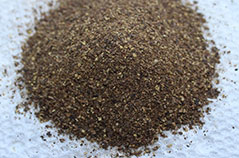
Black Pepper
Native to South India, black pepper, in whole or powdered or crushed form, is used as a spice or seasoning all over the world. In ancient times, black pepper was so expensive that it was used as a currency or collateral. Even today, black pepper is known as king of spices and is highly demanded spice around the world.
Black pepper powder is made by grinding the black peppercorns. Black peppercorns are made by picking the pepper berries when they are half ripe. Then they are dried in sun over a period of time, which causes them to shrivel and become dark in color. Because of their hard and shriveled texture, black peppercorns are easily ground in a pepper mill and taste best in this form. You can also powder the peppercorns by slightly roasting for 2-3 minutes and then grinding in a spice or coffee grinder (as always, do not use the same grinder for spices and coffee). As with all spices, roasting enhances the flavor of peppercorns. Buy peppercorns that are blemish free, heavy for their size, and compact.
Black pepper in any form is very flavorful and pungent and is used around the world to brighten the taste and aroma of a variety of dishes, from appetizers to desserts. In addition to enhancing the taste of food, it also acts as an appetite and taste buds stimulator and improves digestion. It acts as an antioxidant and is a good source of dietary fiber, vitamin K, and minerals such as iron and manganese.
Whole as well as ground/powdered black pepper is stored in air tight container in a cool, dark, and dry place. Black pepper powder can be stored at room temperature for 4-6 months while whole peppercorns last up to a year. You can also freeze them to last for up to 2 years.
Whole black peppercorns or powdered black pepper is available in any grocery store. You can also buy it at online grocery stores. My favorite is amazon.com. However, you can explore other online resource as well.
Black pepper powder is made by grinding the black peppercorns. Black peppercorns are made by picking the pepper berries when they are half ripe. Then they are dried in sun over a period of time, which causes them to shrivel and become dark in color. Because of their hard and shriveled texture, black peppercorns are easily ground in a pepper mill and taste best in this form. You can also powder the peppercorns by slightly roasting for 2-3 minutes and then grinding in a spice or coffee grinder (as always, do not use the same grinder for spices and coffee). As with all spices, roasting enhances the flavor of peppercorns. Buy peppercorns that are blemish free, heavy for their size, and compact.
Black pepper in any form is very flavorful and pungent and is used around the world to brighten the taste and aroma of a variety of dishes, from appetizers to desserts. In addition to enhancing the taste of food, it also acts as an appetite and taste buds stimulator and improves digestion. It acts as an antioxidant and is a good source of dietary fiber, vitamin K, and minerals such as iron and manganese.
Whole as well as ground/powdered black pepper is stored in air tight container in a cool, dark, and dry place. Black pepper powder can be stored at room temperature for 4-6 months while whole peppercorns last up to a year. You can also freeze them to last for up to 2 years.
Whole black peppercorns or powdered black pepper is available in any grocery store. You can also buy it at online grocery stores. My favorite is amazon.com. However, you can explore other online resource as well.

Lime Juice
Lime juice or juice extracted from lime is a great source of vitamin C and used to add tartness and freshness to food and beverages. It also a natural preservative and slows down the spoilage of food. The juice is squeezed from fresh cut lime or bought readymade at grocery stores or supermarkets.
Best quality lime is bright deep green in color and is firm and heavy for its size. More ripen lime turn yellow in color; however it is best when green. Lime produces more juice when warmer. Therefore, to get the most juice out of lime, bring it to room temperature (if refrigerated) and roll it under your palm against a hard surface to warm it more, before squeezing. Another quick method is to microwave it for 15-30 seconds, let it sit for a few minutes before cutting and squeezing.
In addition to its use in food and drinks, lime juice also provides health benefits that include weight loss, skin care, and improved digestion. Due to the presence of significant amount of vitamin C, it helps in curing scurvy, which is caused due to vitamin C deficiency. Vitamin C in lime juice also acts as an antioxidant and helps in strengthening the immune system.
Lime or packaged lime juice is available in grocery stores throughout the year. Lime will stay fresh for a week at room temperature when kept away from sunlight. You can also store it in your refrigerator’s crisper tray for about a month, if bought fresh.
Best quality lime is bright deep green in color and is firm and heavy for its size. More ripen lime turn yellow in color; however it is best when green. Lime produces more juice when warmer. Therefore, to get the most juice out of lime, bring it to room temperature (if refrigerated) and roll it under your palm against a hard surface to warm it more, before squeezing. Another quick method is to microwave it for 15-30 seconds, let it sit for a few minutes before cutting and squeezing.
In addition to its use in food and drinks, lime juice also provides health benefits that include weight loss, skin care, and improved digestion. Due to the presence of significant amount of vitamin C, it helps in curing scurvy, which is caused due to vitamin C deficiency. Vitamin C in lime juice also acts as an antioxidant and helps in strengthening the immune system.
Lime or packaged lime juice is available in grocery stores throughout the year. Lime will stay fresh for a week at room temperature when kept away from sunlight. You can also store it in your refrigerator’s crisper tray for about a month, if bought fresh.
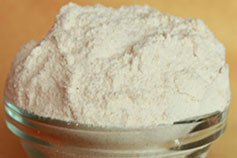
Whole Wheat Flour
Whole wheat flour is obtained by pulverizing whole grain of wheat containing germ (the sprouting part) and the bran (the outer coating). It is used as a main ingredient to make a variety of baking items, such as breads and buns, muffins, cookies and biscuits, pitas, and scones and rolls. Other use of wheat flour is to make pancakes and flat breads like roti and parathas (popular in South Asian counties). Wheat flour is also a main ingredient in making pasta.
Whole wheat flour is a good source of carbohydrates that helps fuel our body. The health benefit reduces when whole wheat flour is processed by removing 40% original wheat flour and replacing it with bleached white flour to commercially produce baked goods, such as breads, pastas, donuts, noodles, cakes, and cookies. Whole wheat flour mixed with other grains, such as oats, grams, and barley (called multigrain flour) is a very good source of proteins, dietary fiber and micronutrients, such as copper, manganese, and magnesium. Indian flat breads such as rotis, parathas, and puris are made at home with whole wheat flour or multigrain flour, which makes the breads really nutritious.
Whole wheat flour is also a good source of proteins. There are 30 different types of proteins in whole wheat flour; however, glutenin and gliadin are the ones responsible for forming an elastic protein called gluten. When the flour is mixed with water and knead to make a dough for baking (or cooking with different methods), glutenin and gliadin absorbs water and comes into contact with each other to form gluten. Gluten protein loses water and becomes hard as it loses moisture during cooking, which gives structure to several baked food and donuts and breads cooked using different methods such as deep frying or cooking on griddle.
Packaged wheat flour has an expiry date on it, so purchase the flour by making sure that it has not expired. After opening the package, wheat flour is best stored in a sealed container in a dry and dark place at room temperature for about 3 months. If kept in refrigerator, it can be used up to 6 months after opening. For longer shelf life of about a year, wheat flour needs to be stored in a freezer.
Whole wheat flour is available in supermarkets and Indian or South Asian grocery stores. It is available at online grocery stores such as amazon.com.
Whole wheat flour is a good source of carbohydrates that helps fuel our body. The health benefit reduces when whole wheat flour is processed by removing 40% original wheat flour and replacing it with bleached white flour to commercially produce baked goods, such as breads, pastas, donuts, noodles, cakes, and cookies. Whole wheat flour mixed with other grains, such as oats, grams, and barley (called multigrain flour) is a very good source of proteins, dietary fiber and micronutrients, such as copper, manganese, and magnesium. Indian flat breads such as rotis, parathas, and puris are made at home with whole wheat flour or multigrain flour, which makes the breads really nutritious.
Whole wheat flour is also a good source of proteins. There are 30 different types of proteins in whole wheat flour; however, glutenin and gliadin are the ones responsible for forming an elastic protein called gluten. When the flour is mixed with water and knead to make a dough for baking (or cooking with different methods), glutenin and gliadin absorbs water and comes into contact with each other to form gluten. Gluten protein loses water and becomes hard as it loses moisture during cooking, which gives structure to several baked food and donuts and breads cooked using different methods such as deep frying or cooking on griddle.
Packaged wheat flour has an expiry date on it, so purchase the flour by making sure that it has not expired. After opening the package, wheat flour is best stored in a sealed container in a dry and dark place at room temperature for about 3 months. If kept in refrigerator, it can be used up to 6 months after opening. For longer shelf life of about a year, wheat flour needs to be stored in a freezer.
Whole wheat flour is available in supermarkets and Indian or South Asian grocery stores. It is available at online grocery stores such as amazon.com.
Share your thoughts and questions!


